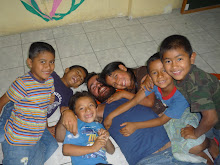Google map: http://maps.google.co.uk/maps?f=q&source=s_q&hl=pt-PT&geocode=&q=%22Parque+Arqueol%C3%B3gico+Nacional+de+Tierradentro%E2%80%8E%22+colombia&ie=UTF8&ll=2.287295,-75.989685&spn=1.344722,2.801514&z=9
Not much is know about the civilisation that between the 7th and 14th centuries AD left remarkable tombs and funerary statuary in the area of Tierradentro. The news is that they weren’t exterminated by Europeans – when Colombus and his men first arrived at the Americas these people had already gone. Mysteriously.
The fact they didn’t have a written language didn’t help in leaving records behind… But it must have been a pretty advanced culture, for the time and resources they had available to dedicate to the cult of the dead. And if not that, the beauty of the tombs – many of which with paintings surviving till today – makes you reach a similar conclusion.
The tombs were used for both primary and secondary buries. This means they would bury the dead a first time around, only to come back a few years later, recover the bones, and bury them again in ceramic pots, incinerating them first or not. Other times, depending on the person being buried, they would go straight to the secondary phase, incinerating the body and leaving to rest the ashes once and for all. It’s not clear who would receive such “privilege”, or why.
As in most cultures of celebration of the dead, the bodies were buried with several artefacts that would be of use in the afterlife – personal belongings, weapons, food, gold artefacts, etc. Sometimes they would even bury women alive along with their late husbands, so that they could keep them company. Isn’t that sweet?
Of course, after years and years of theft not much is left from such artefacts. Most of them rest now in private collections around the western world.
If not much is known about this civilisation, the same cannot be said about the indigenous people that occupied these lands shortly after, and that barely survived the Spanish invasion and the centuries of discrimination that followed – the Paeces.
They’re a very small minority – like all indigenous communities in Colombia – and live scattered around the mountains in small villages. When this region was devastated by a strong earthquake in 1994, many people died and many more were left without a home or any possessions. Help came from Colombia and abroad, injecting funds for reconstruction and providing materials for the new homes, clothes, etc.
The irony? Much of their culture has been lost since then, with the traditional ways of building homes and dressing being substituted by more modern alternatives, like bricks & mortar and the “beautiful” zinc for the houses, or jeans and “Iron Maiden” t-shirts for the body.
To me this raised a few interesting issues... It’s hard to predict the full-fledge impact of external intervention – even the best of intentions can screw things up. And is it a bad thing for such a community to want to modernise itself? Is one really concerned with the preservation of their culture, or is it more of a paternalistic wish to keep things nice and picturesque, like in a museum?
Either way, one thing seems to hold true: when you’re in the marginalised fringes of society, everything seems to pull you further down – even those who are trying to help…



In addition to the tombs, another good reason to visit Tierradentro is the amazing Andean landscape that surrounds it. Although I had been in the Colombian Andes a few times before, spending a few days in the small villages scattered around this incredibly difficult terrain, and witnessing the nightmare that it is to travel around here, made me experience the beauty and the colossal nature of this landscape in a different way
Rough rides. Travelling around here is incredibly difficult - I've experienced the worse roads thus far on this trip. It took me 5 long hours to get from Popayán to Tierradentro, a distance which is not much more than 100km (check in the Google map). Here, I'm in the first leg of the journey that would take from Tierradentro to San Agustín. I'd have to take 4 different buses (actually, not buses - 4WDs, as normal buses don't survive long here!) and endure close to 12 hours of very very bumpy roads to finally get there. Again, if you see it in the map, San Agustín seems to be "just there"...








No comments:
Post a Comment